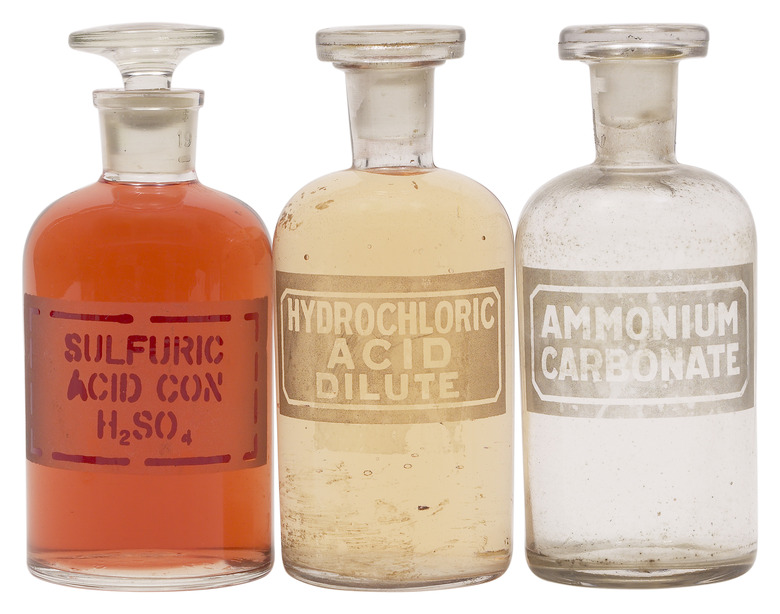How To Make A 50% Normal Solution Of Hydrochloric Acid
Normality describes the number of hydrogen ions that break free from one liter of an acid in the presence of a base, or the number of hydroxide ions that break free from a base in the presence of an acid. In some instances, this can be a more useful measurement than molarity, which describes only the number of acidic or basic molecules per liter, because different acids and bases produce different numbers of ions. When you create a 50 percent normal hydrochloric acid solution, it will always have the same number of ions as every other solution of the same normality.
Step 1
Add the molar mass of hydrogen (1.007 g/mol) and chlorine (35.45 g/mol) to determine the molar mass of hydrochloric acid (36.457 g/mol). Each element's molar mass equals its atomic mass listed on the Periodic Table of Elements.
Step 2
Divide the molar mass of hydrochloric acid by the number of hydrogen ions released by each molecule to calculate the equivalent mass. Since there is only one hydrogen atom, there can only be one ion; therefore the equivalent mass is 36.457/1 or 36.457.
Step 3
Substitute the equivalent mass (EqM), the desired normality (0.5 N) and the desired volume of the solution in liters (L) into the equation EqM * N * L to calculate the number of grams of hydrochloric acid you need to make the solution. For example, if you want to make 1 ltr. of the solution, the equation would be 36.457 * 0.5 * 1.
Step 4
Simplify the equation. For example, in the case of a 1 ltr. solution, you would need 18.2285 gm of pure hydrochloric acid. However, strong acids, such as hydrochloric acid, are never sold in their pure state, so you need to make more calculations.
Step 5
Examine the container of acid determine its percent concentration and specific gravity. Hydrochloric acid is often 37 percent acid and 63 percent water, a concentration which has a specific gravity of 1.19 gm per ml.
Step 6
Substitute the necessary grams of hydrochloric acid (G), the percent concentration (C), and the specific gravity (SG) into the equation G/(C * SG) to calculate the volume of the diluted acid you need to use.
For example, 18.2285 / (0.37 * 1.19) = 41.4 ml.
Step 7
Fill a beaker with water halfway to the desired volume of the solution.
Step 8
Add the amount of solution you calculated while stirring constantly.
Step 9
Top off the solution with water until you reach the desired volume.
Things Needed
- Periodic Table of Elements
- Beaker
- Water
- Stirring rod
Cite This Article
MLA
Arnold, Kylene. "How To Make A 50% Normal Solution Of Hydrochloric Acid" sciencing.com, https://www.sciencing.com/make-50-normal-solution-hydrochloric-acid-10018379/. 24 April 2017.
APA
Arnold, Kylene. (2017, April 24). How To Make A 50% Normal Solution Of Hydrochloric Acid. sciencing.com. Retrieved from https://www.sciencing.com/make-50-normal-solution-hydrochloric-acid-10018379/
Chicago
Arnold, Kylene. How To Make A 50% Normal Solution Of Hydrochloric Acid last modified March 24, 2022. https://www.sciencing.com/make-50-normal-solution-hydrochloric-acid-10018379/
